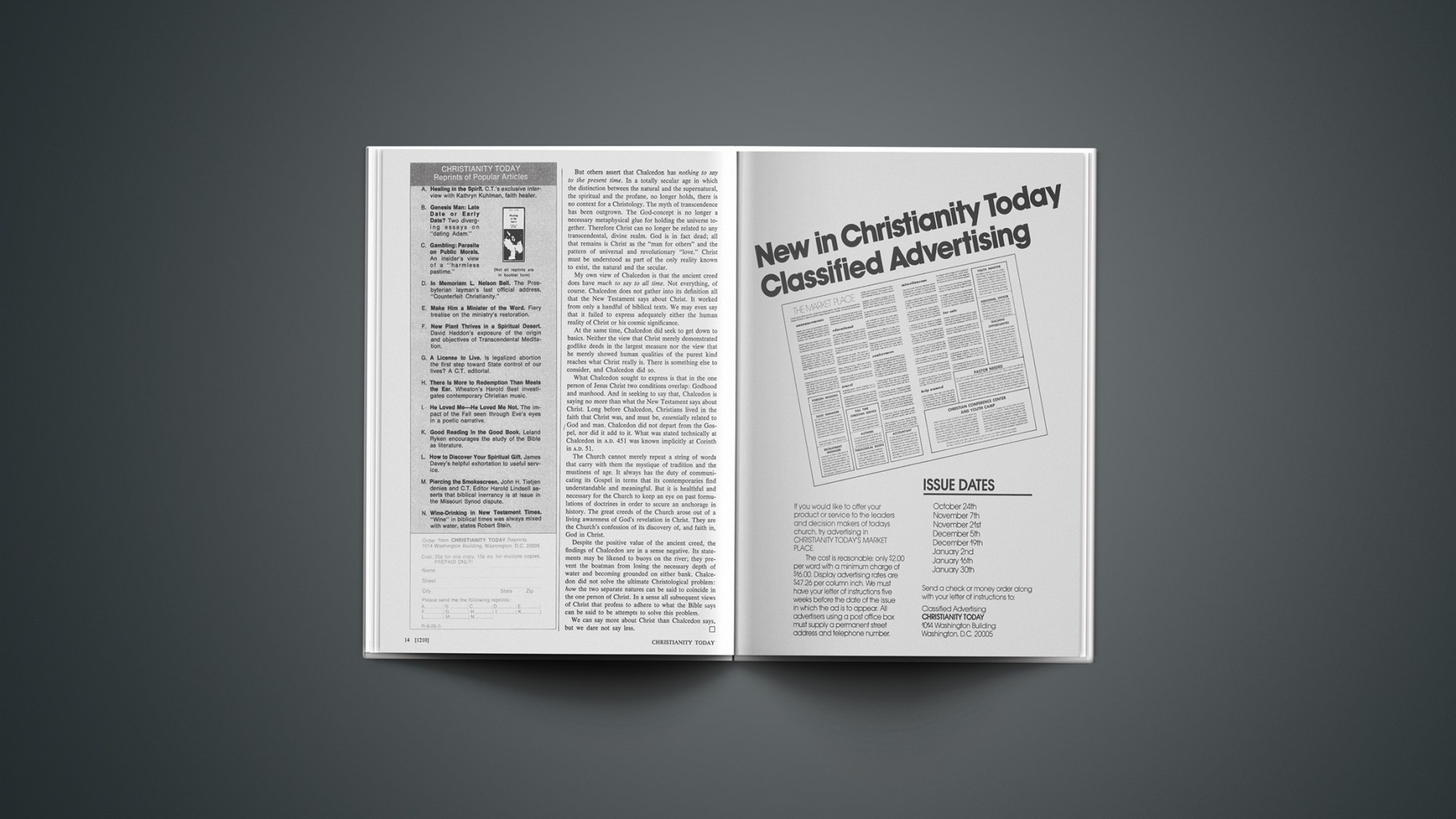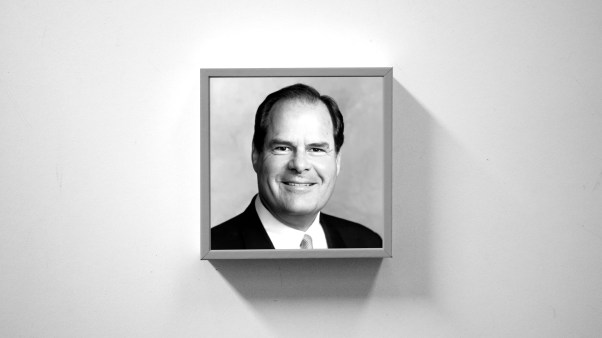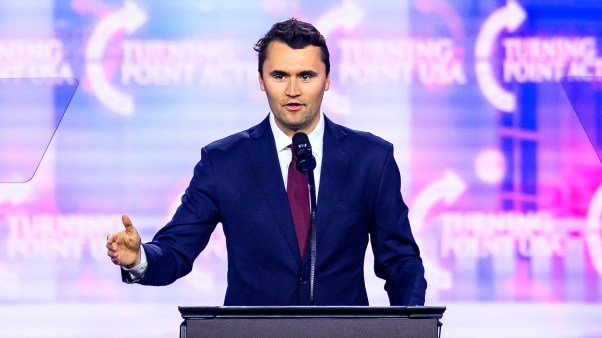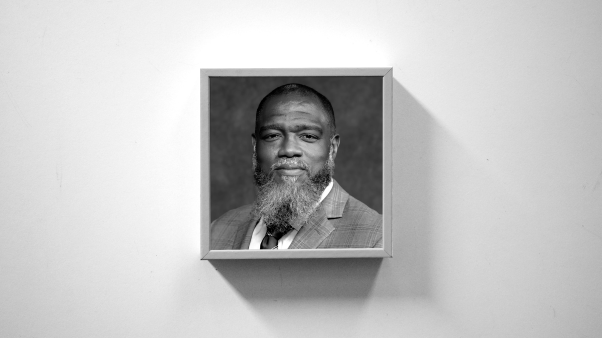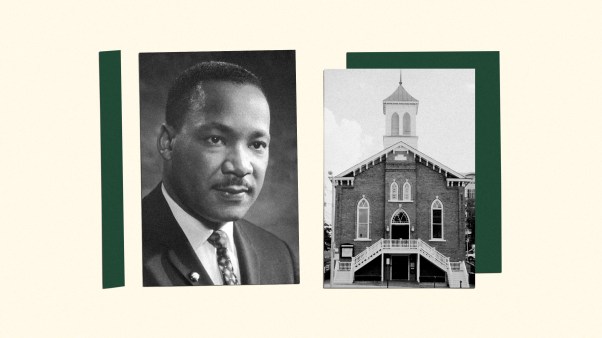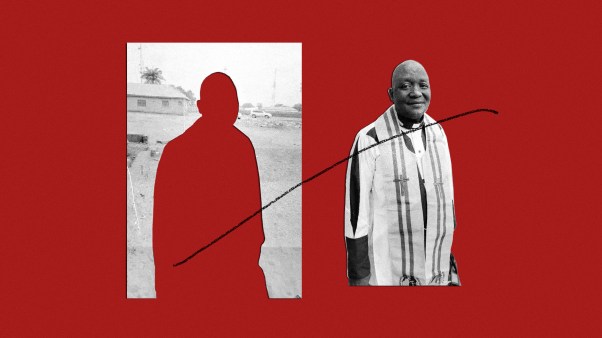From the very first, the Church testified that Jesus Christ belonged to the realm of divine reality as truly as he belonged to the human. But by confronting the world with the news that in the God-man Jesus Christ holy God and sinful man are reconciled, the Church found itself compelled to think through what it meant in saying this. Just who is this Christ, this one through whom man encounters God? If it was to present this Christ to a philosophical, critical, and unbelieving world, the Church had to uncover the deep meaning of its faith in him. And it had to find words to express this meaning.
The need to formulate a doctrine that would take full account of the person of Christ as at once human and divine was all the more pressing because some within the Church itself were confused. They were undervaluing either his divine or the human side, or both. The attempts of the Church to state with ever greater precision what it believed about Christ culminated in A.D. 451 in the council of Chalcedon.
This gathering of church leaders produced an elaborate statement, the Creed of Chaleedon. The creed is widely known, but it is couched in highly technical and metaphysical terms such as “homoousion,” “physis,” and “hypostasis.” Just what did Chalcedon achieve? Did it preserve the essential meaning of the Gospel, or did it lose it in a maze of philosophical abstractions? Did it merely focus attention upon the ultimate mystery of Christ’s person without trying to explain that mystery? Do its high-sounding phrases simply show that metaphysical terms are inadequate to express the doctrine of Christ? These questions may be funneled into a larger one: What is the significance of Chalcedon for us today?
For some, perhaps for many, Chalcedon says everything for all time. This is, according to H. E. W. Turner, the “classical theory,” the theory that the Creed of Chalcedon preserves “unsullied and undefiled” the whole of the Christian doctrine of Christ. W. H. Relton strongly criticizes those who would dismiss the “enormous labours and the acute thoughts of those many minds of the early church” who at Chalcedon sought to make explicit the Church’s faith in Christ. For him, Chalcedon is the grand climax of Christological thinking and the touchstone for all later statements.
At the opposite end of the scale are those who contend that Chalcedon says nothing for any time. The result of this radical view, much in favor today, is that “modern Christologies” tend to reduce Christ to something much less than what Chalcedon held him to be. They take their point of departure from below and never get beyond that. Bultmann took objection to the confession of the World Council of Churches that Christ is “God and Saviour.” The formula “Christ is God” is, he declared, false in every sense. Tillich was equally emphatic in saying that a Christology based on the term homoousion (“of the same essence” [with the Father]) is a “Christology of absurdities.”
Professor Maurice Wiles thinks that traditional Christology rests on a mistake. “It arose,” he contends, “because it was not unnaturally yet nonetheless mistakenly, felt that the full character of redemption in Christ could only be maintained if the person and act of the redeemer were understood to be divine in a direct and special sense.” In his view, Chalcedon gave Christ a status far from the thought and need of the apostolic church.
Between these two opposing positions—that Chalcedon says everything and says nothing—are more moderate views. For example, some say that Chalcedon did say something to its own time. It did try to put into contemporary language what the Church from the beginning thought about Christ, and for this the Fathers of the 451 creed are to be commended. But the mind of the fifth century differs so greatly from that of the twentieth that we are no longer able to build a meaningful Christology using Chalcedon’s outmoded terms.
Two attitudes follow from this understanding of the Chalcedonian formula. On the one hand are those who think that Chalcedon can say something to our time. Barth, for example, says that Chalcedon’s declaration of two natures in the one person of Christ does not explain his person but rather underlines its mystery. It was the best the church fathers could do, given the prevailing static view of the concept “person.” But now that the idea of person is understood dynamically, it is better, in Barth’s judgment, to substitute for the doctrine of two natures that of two states. This better describes the twofold movement of God to man and man to God, uniting in the God-man. Norman Pittenger contends that no Christology can be finally acceptable if it is not faithful to the “intentions and objectives” of the ancient symbols. Wolfhart Pannenberg states his unhappiness with the Chalcedonian formula “truly God, truly man” because he cannot see how two complete beings can be supposed to come together to form a single whole. He therefore opts for the idea of “selfconsciousness to replace that of person.” Karl Rahner thinks that we must view Chalcedon “as end and as beginning.”
But others assert that Chalcedon has nothing to say to the present time. In a totally secular age in which the distinction between the natural and the supernatural, the spiritual and the profane, no longer holds, there is no context for a Christology. The myth of transcendence has been outgrown. The God-concept is no longer a necessary metaphysical glue for holding the universe together. Therefore Christ can no longer be related to any transcendental, divine realm. God is in fact dead; all that remains is Christ as the “man for others” and the pattern of universal and revolutionary “love.” Christ must be understood as part of the only reality known to exist, the natural and the secular.
My own view of Chalcedon is that the ancient creed does have much to say to all time. Not everything, of course. Chalcedon does not gather into its definition all that the New Testament says about Christ. It worked from only a handful of biblical texts. We may even say that it failed to express adequately either the human reality of Christ or his cosmic significance.
At the same time, Chalcedon did seek to get down to basics. Neither the view that Christ merely demonstrated godlike deeds in the largest measure nor the view that he merely showed human qualities of the purest kind reaches what Christ really is. There is something else to consider, and Chalcedon did so.
What Chalcedon sought to express is that in the one person of Jesus Christ two conditions overlap: Godhood and manhood. And in seeking to say that, Chalcedon is saying no more than what the New Testament says about Christ. Long before Chalcedon, Christians lived in the faith that Christ was, and must be, essentially related to God and man. Chalcedon did not depart from the Gospel, nor did it add to it. What was stated technically at Chalcedon in A.D. 451 was known implicitly at Corinth in A.D. 51.
The Church cannot merely repeat a string of words that carry with them the mystique of tradition and the mustiness of age. It always has the duty of communicating its Gospel in terms that its contemporaries find understandable and meaningful. But it is healthful and necessary for the Church to keep an eye on past formulations of doctrines in order to secure an anchorage in history. The great creeds of the Church arose out of a living awareness of God’s revelation in Christ. They are the Church’s confession of its discovery of, and faith in, God in Christ.
Despite the positive value of the ancient creed, the findings of Chalcedon are in a sense negative. Its statements may be likened to buoys on the river; they prevent the boatman from losing the necessary depth of water and becoming grounded on either bank. Chalcedon did not solve the ultimate Christological problem: how the two separate natures can be said to coincide in the one person of Christ. In a sense all subsequent views of Christ that profess to adhere to what the Bible says can be said to be attempts to solve this problem.
We can say more about Christ than Chalcedon says, but we dare not say less.
The Definition of Chalcedon
THEREFORE, FOLLOWING THE HOLY FATHERS, WE ALL WITH ONE ACCORD TEACH MEN TO ACKNOWLEDGE ONE AND THE SAME SON, OUR LORD JESUS CHRIST, AT ONCE COMPLETE IN GODHEAD AND COMPLETE IN MANHOOD, TRULY GOD AND TRULY MAN, CONSISTING ALSO OF A REASONABLE SOUL AND BODY; OF ONE SUBSTANCE WITH THE FATHER AS REGARDS HIS GODHEAD, AND AT THE SAME TIME OF ONE SUBSTANCE WITH US AS REGARDS HIS MANHOOD; LIKE US IN ALL RESPECTS, APART FROM SIN; AS REGARDS HIS GODHEAD, BEGOTTEN OF THE FATHER BEFORE THE AGES, BUT YET AS REGARDS HIS MANHOOD BEGOTTEN, FOR US MEN AND FOR OUR SALVATION, OF MARY THE VIRGIN, THE GOD-BEARER; ONE AND THE SAME CHRIST, SON, LORD, ONLY-BEGOTTEN, RECOGNIZED IN TWO NATURES, WITHOUT CONFUSION, WITHOUT CHANGE, WITHOUT DIVISION, WITHOUT SEPARATION; THE DISTINCTION OF NATURES BEING IN NO WAY ANNULLED BY THE UNION, BUT RATHER THE CHARACTERISTICS OF EACH NATURE BEING PRESERVED AND COMING TOGETHER TO FORM ONE PERSON AND SUBSISTENCE, NOT AS PARTED OR SEPARATED INTO TWO PERSONS, BUT ONE AND THE SAME SON AND ONLY-BEGOTTEN GOD THE WORD, LORD JESUS CHRIST; EVEN AS THE PROPHETS FROM EARLIEST TIMES SPOKE OF HIM, AND OUR LORD JESUS CHRIST HIMSELF TAUGHT US, AND THE CREED OF THE FATHERS HAS HANDED DOWN TO US.

